Growth Response of Wheat and Maize to Different Nitrogen Supply Forms under the Enrichment of Atmospheric CO2 Concentrations
Abstract
:1. Introduction
2. Materials and Methods
2.1. Sand Culture Experiment
2.2. Experimental Design
2.3. Measurement Indices and Methods
2.4. Data Analysis
3. Results
3.1. Response of Wheat and Maize to N Forms under Different Atmospheric CO2 Concentrations in Morphological Traits
3.2. Response of Wheat and Maize in Biomass to Different N Supply Forms under Different Atmospheric CO2
3.3. Responses of C and N Concentrations in the Root Exudates to Different N Forms and Atmospheric CO2 Concentrations for Wheat and Maize
3.4. C and N Concentrations in the Aboveground and Belowground Biomass under Different N Supply Forms and Atmospheric CO2 Concentrations
4. Discussion
4.1. Response of Plant Growth on Different N Supply Forms
4.2. Response of Plant Growth to N Supply Forms under Elevated Atmospheric CO2 Concentrations
5. Conclusions
Author Contributions
Funding
Data Availability Statement
Conflicts of Interest
References
- WMO. The state of greenhouse gases in the atmosphere based on global observations through 2020. WMO Greenh. Gas Bull 2021, 17, 1–10. [Google Scholar]
- IPCC. Climate Change 2021: The Physical Science Basis. Contribution of Working Group I to the Sixth Assessment Report of the Intergovernmental Panel on Climate Change; Pachauri, R.K., Meyer, L.A., Eds.; IPCC: Geneva, Switzerland, 2021. [Google Scholar]
- Lee, S.H.; Megonigal, P.J.; Langley, A.J.; Kang, H. Elevated CO2 and nitrogen addition affect the microbial abundance but not the community structure in salt marsh ecosystem. Appl. Soil Ecol. 2017, 117–118, 129–136. [Google Scholar] [CrossRef]
- Atia, A.; Rabhi, M.; Debez, A.; Abdelly, C.; Gouia, H.; Haouari, C.C.; Smaoui, A. Ecophysiological aspects and photosynthetic pathways in 105 plants species in saline and arid environments of Tunisia. J. Arid Land 2014, 6, 762–770. [Google Scholar] [CrossRef]
- Wang, F.; Gao, J.; Yong, J.W.H.; Wang, Q.; Ma, J.; He, X. Higher atmospheric CO2 levels favor C3 plants over C4 plants in utilizing ammonium as a nitrogen source. Front. Plant Sci. 2020, 11, 537443. [Google Scholar] [CrossRef] [PubMed]
- Ma, Z.L.; Zhao, W.Q. Research progress on input of plant community-derived soil organic carbon and its responses to climate warming. Chin. J. Ecol. 2020, 39, 270–281, (In Chinese with English abstract). [Google Scholar]
- Wang, B.; Wang, Y.F.; Guo, C.; Li, Y.E.; You, S.C.; Qin, X.B.; Chen, H.L. Effects of elevated air temperature and carbon dioxide concentration on nitrogen use of double rice (Oryza sativa L.) in Open-top Chambers. Acta Agron. Sin. 2015, 41, 1295–1303, (In Chinese with English abstract). [Google Scholar] [CrossRef]
- Bloom, A.J.; Kasemsap, P.; Rubio-Asensio, J.S. Rising atmospheric CO2 concentration inhibits nitrate assimilation in shoots but enhances it in roots of C3 plants. Physiol. Plant. 2019, 168, 963–972. [Google Scholar] [CrossRef]
- Long, S.P.; Ainsworth, E.A.; Rogers, A.; Ort, D.R. Rising atmospheric carbon dioxide: Plants FACE the Future. Annu. Rev. Plant Biol. 2004, 55, 591–628. [Google Scholar] [CrossRef] [PubMed]
- Stitt, M.; Krapp, A. The interaction between elevated carbon dioxide and nitrogen nutrition: The physiological and molecular background. Plant Cell Environ. 1999, 22, 583–621. [Google Scholar] [CrossRef]
- Baker, J.; Allen, L.H.; Boote, K.; Pickering, N. Rice responses to drought under carbon dioxide enrichment 2. Photosynthesis and evapotranspiration. Glob. Change Biol. 2010, 3, 129–138. [Google Scholar] [CrossRef]
- Shimono, H.; Bunce, J.A. Acclimation of nitrogen uptake capacity of rice to elevated atmospheric CO2 concentration. Ann. Bot. 2008, 103, 87–94. [Google Scholar] [CrossRef] [PubMed]
- Del Pozo, A.; Pérez, P.; Morcuende, R.; Alonso, A.; Martínez-Carrasco, R. Acclimatory responses of stomatal conductance and photosynthesis to elevated CO2 and temperature in wheat crops grown at varying levels of N supply in a Mediterranean environment. Plant Sci. 2005, 169, 908–916. [Google Scholar] [CrossRef]
- Li, X.; Khan, A.; Lv, Z.; Fang, L.; Jiang, D.; Liu, F. Effect of multigenerational exposure to elevated atmospheric CO2 concentration on grain quality in wheat. Environ. Exp. Bot. 2019, 157, 310–319. [Google Scholar] [CrossRef]
- Asseng, S.; Jamieson, P.; Kimball, B.; Pinter, P.; Sayre, K.; Bowden, J.; Howden, S. Simulated wheat growth affected by rising temperature, increased water deficit and elevated atmospheric CO2. Field Crops Res. 2004, 85, 85–102. [Google Scholar] [CrossRef]
- Weigel, H.-J.; Manderscheid, R. Crop growth responses to free air CO2 enrichment and nitrogen fertilization: Rotating barley, ryegrass, sugar beet and wheat. Eur. J. Agron. 2012, 43, 97–107. [Google Scholar] [CrossRef]
- Broberg, M.C.; Högy, P.; Feng, Z.; Pleijel, H. Effects of elevated CO2 on wheat yield: Non-linear response and relation to site productivity. Agronomy 2019, 9, 243. [Google Scholar] [CrossRef]
- Dennis, P.G.; Miller, A.J.; Hirsch, P.R. Are root exudates more important than other sources of rhizodeposits in structuring rhizosphere bacterial communities? FEMS Microbiol. Ecol. 2010, 72, 313–327. [Google Scholar] [CrossRef]
- Paterson, E.; Hall, J.M.; Rattray, E.A.S.; Griffiths, B.S.; Ritz, K.; Killham, K. Effect of elevated CO2 on rhizosphere carbon flow and soil microbial processes. Glob. Change Biol. 1997, 3, 363–377. [Google Scholar] [CrossRef]
- Bouranis, L.D.; Chorianopoulou, N. Styliani; Dionias, Alexandros; Sofianou, Giouli; Thanasoulas, Aristotelis; Liakopoulos, Georgios; Nikolopoulos, Dimosthenis. Comparison of the S-, N- or P-Deprivations’ impacts on stomatal conductance, Transpiration and Photosynthetic Rate of Young Maize Leaves. Am. J. Plant Sci. 2012, 3, 1058–1065. [Google Scholar] [CrossRef]
- Adeyemi, T.A.; Adeoye, S.A.; Ogunyemi, T.J.; Adedeji, E.A.; Oluyemi, B.; Ojo, V.O.A. Comparisons of nutrient solutions from organic and chemical fertilizer sources on herbage yield and quality of hydroponically produced maize fodder. J. Plant Nutr. 2020, 3, 1258–1267. [Google Scholar] [CrossRef]
- Di, L.; Dong, J.; Gruda, N.S.; Li, X.; Duan, Z. Elevated root-zone temperature promotes the growth and alleviates the photosynthetic acclimation of cucumber plants exposed to elevated [CO2]. Environ. Exp. Bot. 2022, 194, 104694. [Google Scholar] [CrossRef]
- Richardson, A.E.; Barea, J.; Mcneill, A.M.; Claire, P.C. Acquisition of phosphorus and nitrogen in the rhizosphere and plant growth promotion by microorganisms. Plant Soil 2009, 321, 305–339. [Google Scholar] [CrossRef]
- Gong, X.; Li, L.; Qin, L.; Huang, Y.; Ye, Y.; Wang, M.; Wang, Y.; Xu, Y.; Luo, F.; Mei, H. Targeted metabolomics reveals impact of N application on accumulation of amino acids, Flavonoids and phytohormones in tea shoots under soil nutrition deficiency stress. Forests 2022, 10, 1629. [Google Scholar] [CrossRef]
- Cure, J.D.; Acock, B. Crop response to carbon dioxide doubling: A literature survey. Agric. For. Meteorol. 1986, 38, 127–145. [Google Scholar] [CrossRef]
- Oehlmann, N.N.; Rebelein, J.G. The Conversion of Carbon Monoxide and Carbon Dioxide by Nitrogenases. Chembiochem 2022, 20, e202100453. [Google Scholar] [CrossRef]
- Field, C.B.; Matson, P.A.; Mooncy, H.A. Responses of terrestrial ecosystems to a changing atmosphere. Annu. Rev. Ecol. Syst. 1992, 23, 201–235. [Google Scholar] [CrossRef]
- Zhang, J.; Li, Y.; Yu, Z.; Adams, J.; Tang, C.; Wang, G.; Liu, X.; Liu, J.; Franks, A.; Liu, J.; et al. Elevated atmospheric CO2 and warming enhance the acquisition of soil-derived nitrogen rather than urea fertilizer by rice cultivars. Agric. For. Meteorol. 2022, 324, 109117. [Google Scholar] [CrossRef]
- Dromantienė, R.; Pranckietienė, I.; Jodaugienė, D.; Paulauskienė, A. The Influence of various forms of nitrogen fertilization and meteorological factors on nitrogen compounds in soil under laboratory conditions. Agronomy 2020, 10, 2011. [Google Scholar] [CrossRef]
- Hormoz, B.; Stephen, A.P.; Rich, J.N. A field method of determining NH4+ and NO3−; uptake kinetics in intact roots: Effects of CO2: Enrichment on trees and crop specie. Plant Soil 1999, 217, 123–134. [Google Scholar]
- Gerendás, J.; Zhu, Z.; Bendixen, R.; Ratcliffe, R.G.; Sattelmacher, B. Physiological and biochemical processes related to ammonium toxicity in higher plants. Z. Für Pflanz. Und Bodenkd. 1997, 160, 239–251. [Google Scholar] [CrossRef]
- Wang, X.; Wei, X.; Wu, G.; Chen, S. Ammonium application mitigates the effects of elevated carbon dioxide on the carbon/nitrogen balance of Phoebe bournei seedlings. Tree Physiol. 2021, 41, 1658–1668. [Google Scholar] [CrossRef] [PubMed]
- Asensio, J.S.; Rachmilevitch, S.; Bloom, A.J. Responses of Arabidopsis and wheat to rising CO2 depend on nitrogen source and nighttime CO2 levels. Plant Physiol. 2015, 168, 156–163. [Google Scholar] [CrossRef] [PubMed]
- Ma, Q.; Wang, J.; Sun, Y.; Yang, X.; Ma, J.; Li, T.; Wu, L. Elevated CO2 levels enhance the uptake and metabolism of organic nitrogen. Physiol. Plant 2018, 162, 467–478. [Google Scholar] [CrossRef]
- Maniou, F.; Chorianopoulou, S.N.; Bouranis, D.L. New insights into trophic aerenchyma formation strategy in maize (Zea mays L.) organs during sulfate deprivation. Front. Plant Sci. 2014, 3, 5–581. [Google Scholar] [CrossRef] [PubMed]
- Siyiannis, V.F.; Protonotarios, V.E.; Zechmann, B.; Chorianopoulou, S.N.; Müller, M.; Hawkesford, M.J.; Bouranis, D.L. Comparative spatiotemporal analysis of root aerenchyma formation processes in maize due to sulphate, nitrate or phosphate deprivation. Protoplasma 2012, 249, 671–686. [Google Scholar] [CrossRef] [PubMed]
- Fan, J.; Halpern, M.; Yu, Y.; Zuo, Q.; Shi, J.; Fan, Y.; Wu, X.; Yermiyahu, U.; Sheng, J.; Jiang, P.; et al. The mechanisms responsible for N deficiency in well-watered wheat under elevated CO2. Front. Plant Sci. 2022, 13, 801443. [Google Scholar] [CrossRef]
- Wang, P.; Bi, S.; Wang, S.; Ding, Q. Variation of wheat root exudates under aluminum stress. J. Agric. Food Chem. 2006, 54, 10040–10046. [Google Scholar] [CrossRef]
- Shen, X.; Yuan, Y.; Zhang, H.; Guo, Y.; Zhao, Y.; Li, S.; Kong, F. The Hot QTL locations for Potassium, Calcium, and Magnesium Nutrition and agronomic traits at seedling and maturity stages of wheat under different potassium treatments. Genes 2019, 10, 607. [Google Scholar] [CrossRef]
- Wei, J.; Li, C.; Li, Y.; Jiang, G.; Cheng, G.; Zheng, Y. Effects of external potassium (k) supply on drought tolerances of two contrasting winter wheat cultivars. PLoS ONE 2013, 8, 69737. [Google Scholar] [CrossRef]
- Esteban, R.; Ariz, I.; Cruz, C.; Moran, F.J. Review: Mechanisms of ammonium toxicity and the quest for tolerance. Plant Sci. 2016, 248, 92–101. [Google Scholar] [CrossRef]
- Yang, L.I.; Li, Y.X.; Li, Y.X.; Tian, Z.W.; Hu, J.L.; Adkins, S.; Dai, T.B. Changes of oxidative metabolism in the roots of wheat(Triticum aestivum L.) seedlings in response to elevated ammonium concentrations. J. Integr. Agric. 2021, 20, 1216–1228. [Google Scholar]
- Ravazzolo, L.; Revisan, T.S.; Forestan, C.; Arotto, V.S.; Sut, S.; Dall’Acqua, S.; Malagoli, M.; Quaggiotti, S. Nitrate and ammonium affect the overall maize response to nitrogen availability by triggering specific and common transcriptional signatures in roots. Int. J. Mol. Sci. 2020, 21, 686. [Google Scholar] [CrossRef]
- Usyskin-Tonne, A.; Hadar, Y.; Yermiyahu, U.; Minz, D. Elevated CO2 and nitrate levels increase wheat root-associated bacterial abundance and impact rhizosphere microbial community composition and function. ISME J. 2021, 15, 1073–1084. [Google Scholar] [CrossRef]
- Lapie, C.; Sterckeman, T.; Paris, C.; Leglize, P. Impact of phenanthrene on primary metabolite profiling in root exudates and maize mucilage. Environ. Sci. Pollut. Res. Int. 2020, 27, 3124–3142. [Google Scholar] [CrossRef] [PubMed]
- Xu, Y.; Xiao, Z.; Zhang, X.; Zhao, C.; Li, Y.; Che, T.; Li, Y.; Zang, X.; Jiang, S.; Li, H.; et al. The nutrient preferences of rice and wheat influence fluoranthene uptake. Front. Environ. Sci. 2022, 10, 987743. [Google Scholar] [CrossRef]
- Ochieng’, I.O.; Gitari, H.I.; Mochoge, B.; Rezaei-Chiyaneh, E.; Gweyi-Onyango, J.P. Optimizing Maize Yield, Nitrogen efficacy and grain protein content under different N forms and rates. J. Soil Sci. Plant Nutr. 2021, 21, 1867–1880. [Google Scholar] [CrossRef]
- Kim, T.; Mills, H.A.; Wetzstein, H.Y. Studies on effects of nitrogen form on growth, development, and nutrient uptake in pecan. J. Plant Nutr. 2002, 25, 497–508. [Google Scholar] [CrossRef]
- Lyu, X.; Liu, Y.; Li, N.; Ku, L.; Hou, Y.; Wen, X. Foliar applications of various nitrogen (N) forms to winter wheat affect grain protein accumulation and quality via N metabolism and remobilization. Crop. J. 2022, 10, 1165–1177. [Google Scholar] [CrossRef]
- Miao, Y.F.; Li, S.X.; Xu, X.F.; Wang, Z.H.; Li, X.H.; Fu, Y.Y.; Luo, L.C. Ponses of winter wheat to ammonium and nitrate nitrogen. Acta Pedol. Sin. 2014, 51, 564–574, (In Chinese with English abstract). [Google Scholar]
- Li, S.X.; Wang, Z.H.; Hu, T.T.; Gao, Y.J.; Stewart, B.A. Nitrogen in dryland soils of China and its management. Adv. Agron. 2009, 101, 123–181. [Google Scholar] [CrossRef]
- Britto, D.T.; Kronzucker, H.J. NH4+ toxicity in higher plants: A critical review. J. Plant Physiol. 2002, 159, 567–584. [Google Scholar] [CrossRef]
- Pan, R.Z. Plant Physiology; Frontiers of Philosophy in China: Beijing, China, 2012. [Google Scholar]
- Henriksen, G.H.; Bloom, A.J.; Spanswick, R.M. Measurement of net fluxes of ammonium and nitrate at the surface of barley roots using ion-selective microelectrodes. Plant Physiol. 1990, 93, 271–280. [Google Scholar] [CrossRef] [PubMed]
- Tsay, Y.F.; Ho, C.H.; Chen, H.Y.; Lin, S.H. Integration of nitrogen and potassium signaling. Annu. Rev. Plant Biol. 2011, 62, 207–226. [Google Scholar] [CrossRef] [PubMed]
- Liu, N.; Han, T.; BassiriRad, H. Root proliferation into patches of different nitrogen forms: A 17-plant species study. J. Soil Sci. Plant Nutr. 2022, 22, 2835–2846. [Google Scholar] [CrossRef]
- Gazzarrini, S. Three functional transporters for constitutive, diurnally regulated, and starvation-induced uptake of ammonium into arabidopsis roots. Plant Cell Online 1999, 11, 937–948. [Google Scholar] [CrossRef]
- Li, S.; Yu, K.; Huo, Y.; Zhang, J.; Wu, H.; Cai, C.; Liu, Y.; Shi, D.; He, P. Effects of nitrogen and phosphorus enrichment on growth and photosynthetic assimilation of carbon in a green tide-forming species (Ulva prolifera) in the Yellow Sea. Hydrobiologia 2016, 776, 161–171. [Google Scholar] [CrossRef]
- Imran, M.; Hu, C.X.; Hussain, S.; Rana, M.S.; Riaz, M.; Afzal, J.; Aziz, O.; Elyamine, A.M.; Ismael, M.A.F.; Sun, X.C. Molybdenum-induced effects on photosynthetic efficacy of winter wheat (Triticum aestivum L.) under different nitrogen sources are associated with nitrogen assimilation. Plant Physiol. Biochem. 2019, 141, 154–163. [Google Scholar] [CrossRef]
- Zainul, A.; Werner, K.H.; Tabassum, H.; Aysha, R.; Alwahibi, M.S.; Elshikh, M.S.; Hussain, M.I.; Zulfiqar, F.; Mansoor, S.; Abbas, Z. Biomass production and predicted ethanol yield are linked with optimum photosynthesis in phragmites karka under salinity and drought conditions. Plants 2022, 11, 1657. [Google Scholar] [CrossRef]
- Hawkesford, M.; Horst, W.; Kichry, T.; Lambers, H.; Schjoerring, J.; Møller, I.S.; White, P. Functions of macronutrients Marschner P. In Marschner’s Mineral Nutrition of Higher Plants; Academic Press: Cambridge, MA, USA, 2011; pp. 135–151. [Google Scholar] [CrossRef]
- Li, Q.; Xu, X.; Gu, H.; Gao, H.; Zhu, Y.; Dong, C.; Shen, Q. Effects of applying different nitrogen form on cherry tomato nitrogen metabolism during fruit development. Chin. J. Appl. Ecol. 2010, 21, 2335–2341. [Google Scholar]
- Yang, Y. Effects of Nitrogen on growth, Quality and Key Enzymes of Nitrogen Metabolism in Rich and Noble Vegetables. Master’s Thesis, Hunan Agricultural University, Changsha, China, 2011. [Google Scholar]
- Su, W. Effect of Elevation CO2 on Nitrogen Uptake Characteristic and Growth of Larix gmelinii and Pinus sylvestris var. mongolic. Master’s Thesis, Northeast Forestry University, Harbin, China, 2018. [Google Scholar]
- Cohen, I.; Rapaport, T.; Berger, R.T.; Rachmilevitch, S. The effects of elevated CO2 and nitrogen nutrition on root dynamics. Plant Sci. 2018, 272, 294–300. [Google Scholar] [CrossRef]
- Tingey, D.T.; Mckane, R.B.; Olszyk, D.M.; Johnson, M.G.; Rygiewicz, P.T.; Henry, L.E. Elevated CO2 and temperature alter nitrogen allocation in douglas-fir. Glob. Change Biol. 2003, 9, 1038–1050. [Google Scholar] [CrossRef]
- Ma, H.; Zhu, J.; Xie, Z.; Ceng, X.; Liu, G. Effects of CO2 enrichment on the allocation of biomass and C, N uptake in rice organs. Chin. J. Eco-Agric. 2005, 3, 38–41, (In Chinese with English abstract). [Google Scholar]
- Hu, G. Effect of nitrogen forms and abiotic stress on tea plant physiological characteristics and nitrogen metabolism. Master’s Thesis, Anhui Agricultural University, Hefei, China, 2018. [Google Scholar]
- Del Amor, F.M.; Piñero, M.C.; Otálora-Alcón, G.; Perez-Jimenez, M.; Marin-Minano, M. Effect of different nitrogen forms and CO2 enrichment on the nutrient uptake and water relations of pepper plants (Capsicum annuun L.). Procedia Environ. Sci. 2015, 29, 203–204. [Google Scholar] [CrossRef]
- Subbarao, G.V.; Nakahara, K.; Ishikawa, T.; Ono, H.; Yoshida, M.; Yoshihashi, T.; Zhu, Y.; Zakir, H.A.K.M.; Deshpande, S.P.; Hash, C.T.; et al. Biological nitrification inhibition (BNI) activity in sorghum and its characterization. Plant Soil 2012, 366, 243–259. [Google Scholar] [CrossRef]
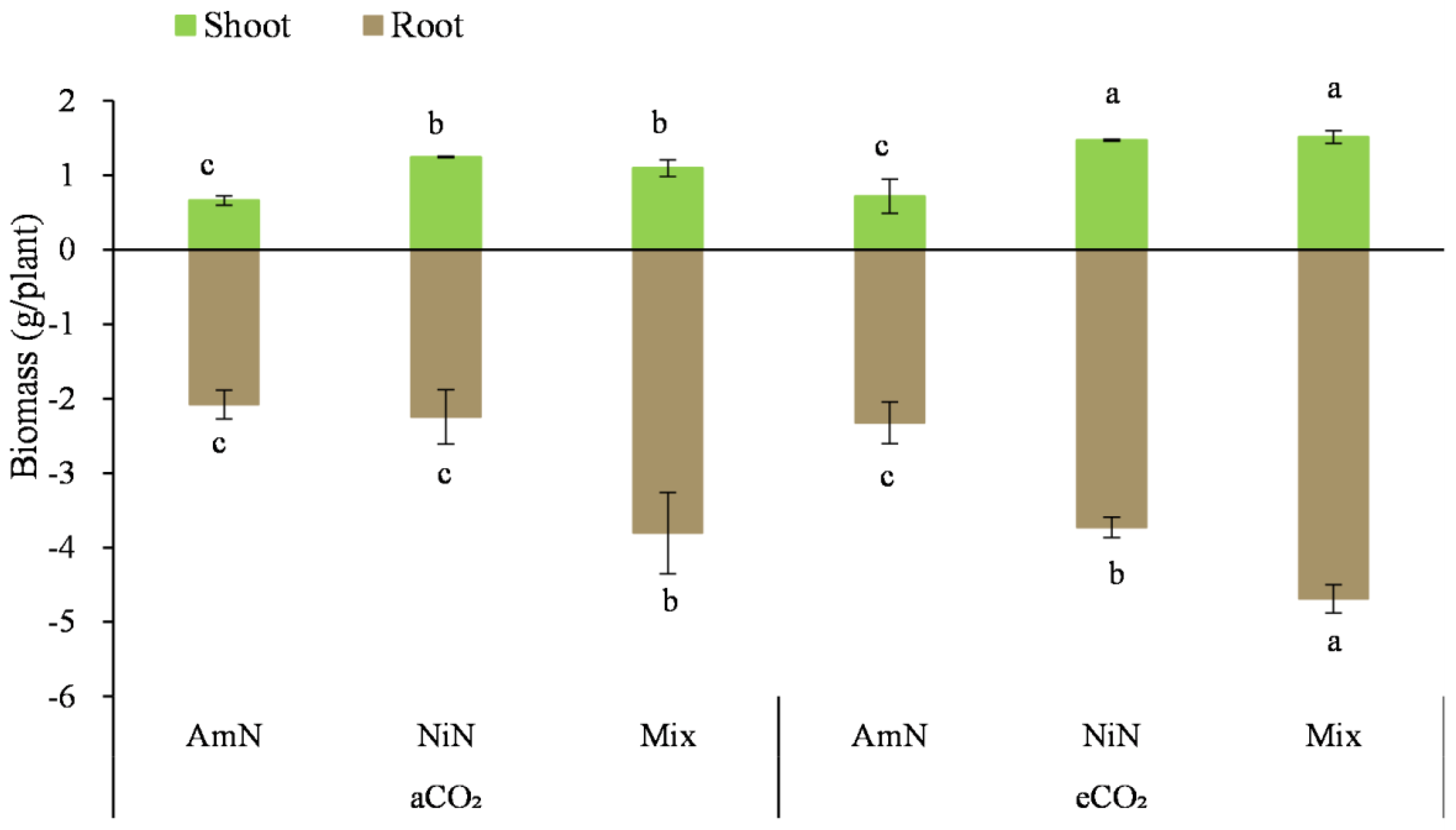
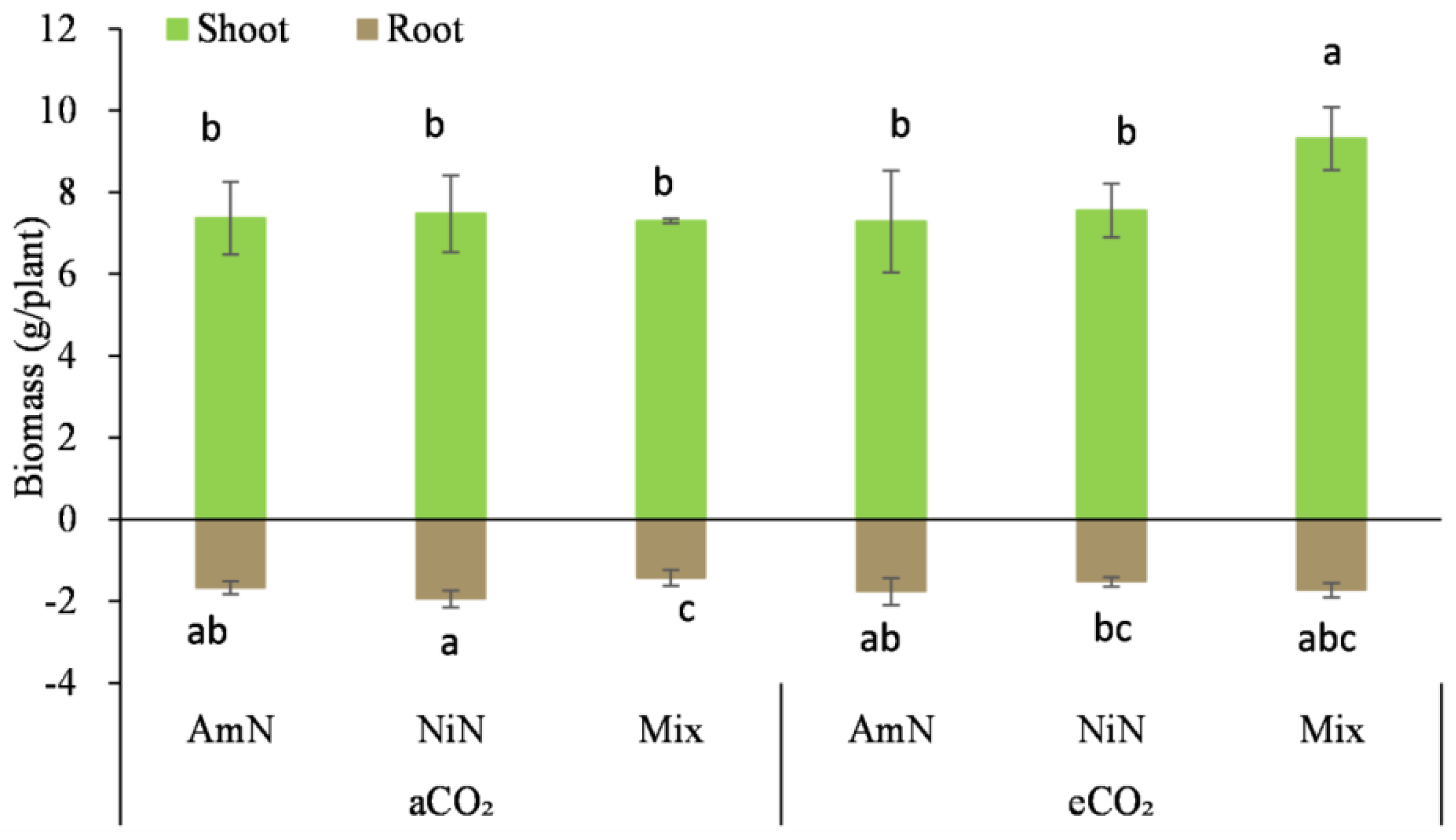
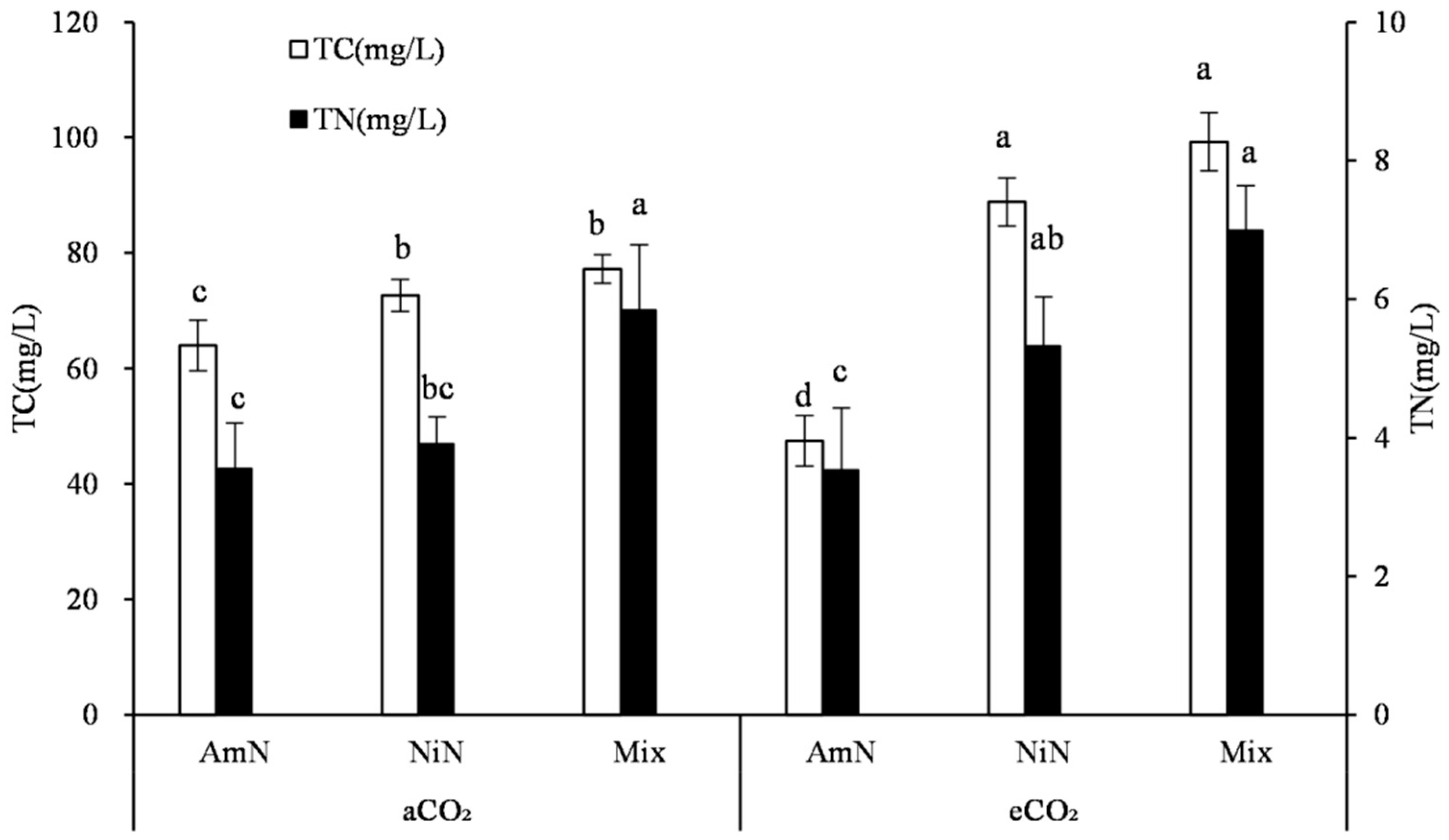
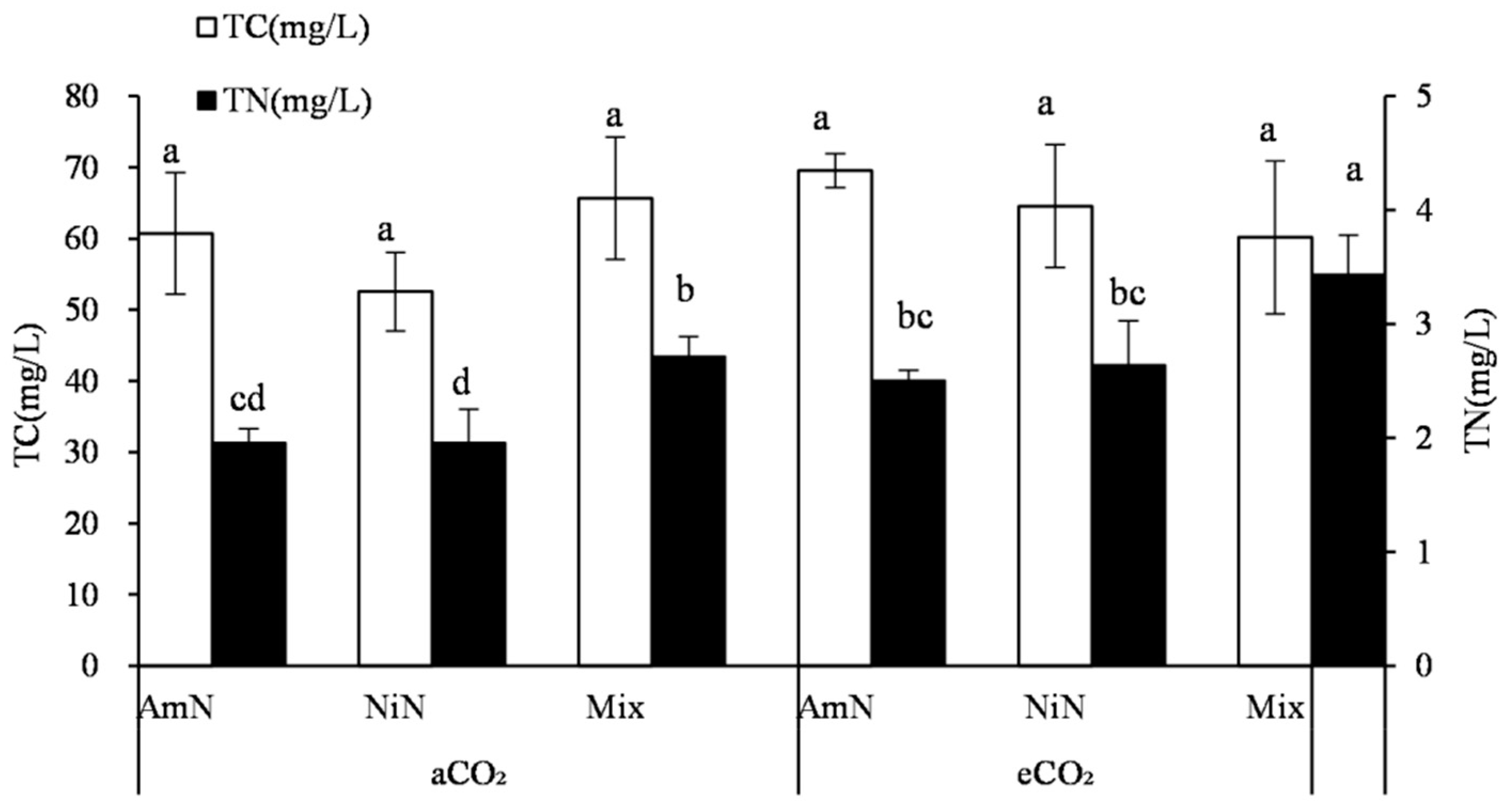
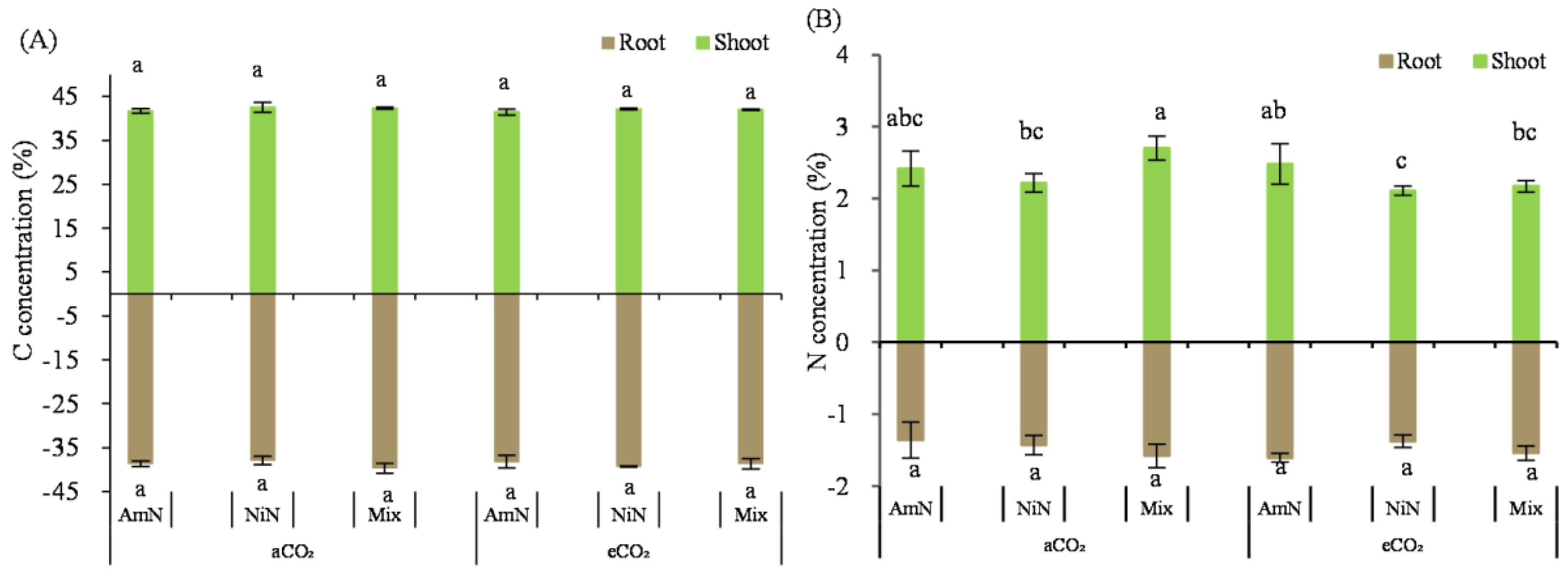


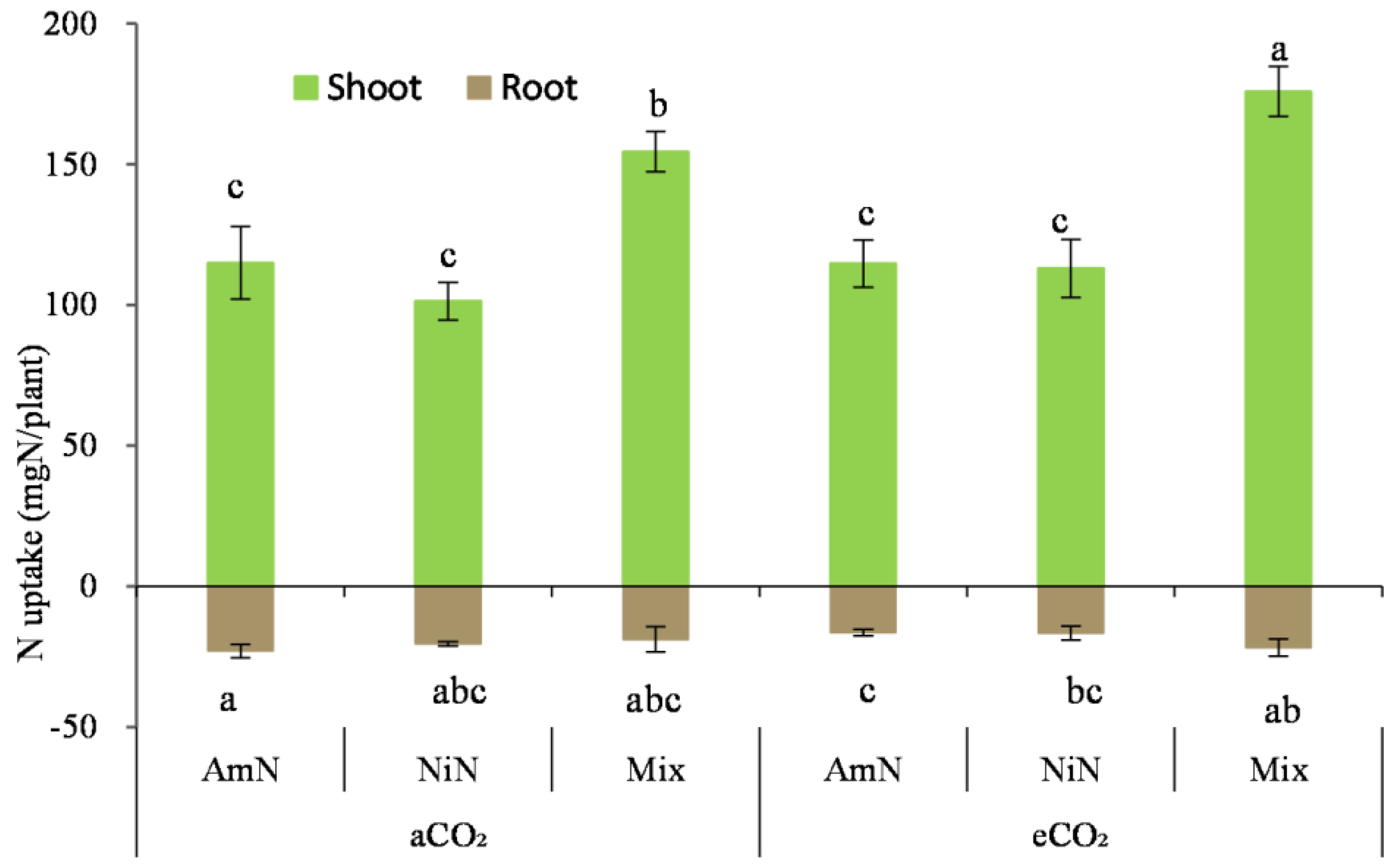
| Treatment | Atmospheric CO2 Concentration | N Supply Form | |||
|---|---|---|---|---|---|
| aCO2 | eCO2 | AmN | NiN | Mix | |
| aCO2−AmN | √ | √ | |||
| aCO2−NiN | √ | √ | |||
| aCO2−Mix | √ | √ | |||
| eCO2−AmN | √ | √ | |||
| eCO2−NiN | √ | √ | |||
| eCO2−Mix | √ | √ | |||
| Treatment | Plant Height (cm) | Maximum Root Length (cm) | Stem Thickness (cm) | Tiller Number | |
|---|---|---|---|---|---|
| aCO₂ | AmN | 49.83 ± 6.6 ab | 25.33 ± 2.0 c | 3.16 ± 0.1 c | 8.33 ± 1.1 c |
| NiN | 43.40 ± 1.8 c | 32.70 ± 4.0 ab | 3.09 ± 0.5 c | 11.00 ± 2.0 bc | |
| Mix | 54.85 ± 3.9 a | 35.20 ± 1.9 a | 4.14 ± 0.3 b | 13.00 ± 2.1 b | |
| eCO₂ | AmN | 50.93 ± 2.1 ab | 29.67 ± 3.4 b | 3.44 ± 0.1 c | 7.67 ± 0.6 c |
| NiN | 47.53 ± 1.2 bc | 33.13 ± 2.1 ab | 3.49 ± 0.1 c | 14.00 ± 2.0 b | |
| Mix | 55.23 ± 2.5 a | 29.53 ± 0.9 b | 4.90 ± 04 a | 18.50 ± 0.7 a | |
| Two-way ANOVA | CO₂ | n.s. | n.s. | ** | * |
| N | * | * | * | ** | |
| CO₂ × N | n.s. | n.s. | n.s. | * | |
| Treatment | Plant Height (cm) | Stem Thickness (cm) | Maximum Root Length (cm) | |
|---|---|---|---|---|
| aCO₂ | AmN | 116.13 ± 8.4 c | 14.16 ± 0.3 a | 38.77 ± 5.9 a |
| NiN | 118.53 ± 3.4 bc | 13.56 ± 0.9 a | 37.60 ± 3.7 a | |
| Mix | 122.57 ± 5.5 bc | 13.61 ± 0.9 a | 36.77 ± 7.4 a | |
| eCO₂ | AmN | 123.00 ± 6.24 bc | 13.53 ± 1.6 a | 36.97 ± 5 a |
| NiN | 127.20 ± 1.0 ab | 13.66 ± 0.4 a | 36.00 ± 3.2 a | |
| Mix | 134.33 ± 1.3 a | 13.55 ± 0.8 a | 41.23 ± 6.5 a | |
| Two-factor ANOVA | CO₂ | * | n.s. | n.s. |
| N | * | n.s. | n.s. | |
| CO₂ × N | n.s. | n.s. | n.s. | |
| Wheat | Shoot Biomass | Root Biomass |
|---|---|---|
| CO2 | ** | ** |
| N | ** | ** |
| CO₂ × N | * | * |
| Maize | Shoot Biomass | Root Biomass |
|---|---|---|
| CO2 | n.s. | n.s. |
| N | n.s. | n.s. |
| CO₂ × N | n.s. | * |
| Wheat | TC | TN |
|---|---|---|
| CO2 | * | * |
| N | ** | ** |
| CO₂ × N | ** | n.s. |
| Maize | TC | TN |
|---|---|---|
| CO2 | n.s. | ** |
| N | n.s. | ** |
| CO₂ × N | n.s. | n.s. |
| Wheat | Shoot C Concentration | Shoot N Concentration | Root C Concentration | Root N Concentration |
|---|---|---|---|---|
| CO2 | n.s. | * | n.s. | n.s. |
| N | n.s. | * | n.s. | n.s. |
| CO₂ × N | n.s. | * | n.s. | n.s. |
| Wheat | Shoot N Uptake | Root N Uptake |
|---|---|---|
| CO2 | ** | ** |
| N | n.s. | ** |
| CO₂ × N | n.s. | n.s. |
| Maize | Shoot C Concentration | Shoot N Concentration | Root C Concentration | Root N Concentration |
|---|---|---|---|---|
| CO2 | * | * | n.s. | * |
| N | n.s. | n.s. | n.s. | n.s. |
| CO₂ × N | n.s. | n.s. | n.s. | n.s. |
| Maize | Shoot N Uptake | Root N Uptake |
|---|---|---|
| CO2 | ** | n.s. |
| N | * | n.s. |
| CO₂ × N | n.s. | * |
Disclaimer/Publisher’s Note: The statements, opinions and data contained in all publications are solely those of the individual author(s) and contributor(s) and not of MDPI and/or the editor(s). MDPI and/or the editor(s) disclaim responsibility for any injury to people or property resulting from any ideas, methods, instructions or products referred to in the content. |
© 2023 by the authors. Licensee MDPI, Basel, Switzerland. This article is an open access article distributed under the terms and conditions of the Creative Commons Attribution (CC BY) license (https://creativecommons.org/licenses/by/4.0/).
Share and Cite
Dong, L.; Li, Y.; Li, P.; Liu, Y.; Ma, F.; Hao, X.; Guo, L. Growth Response of Wheat and Maize to Different Nitrogen Supply Forms under the Enrichment of Atmospheric CO2 Concentrations. Agronomy 2023, 13, 485. https://doi.org/10.3390/agronomy13020485
Dong L, Li Y, Li P, Liu Y, Ma F, Hao X, Guo L. Growth Response of Wheat and Maize to Different Nitrogen Supply Forms under the Enrichment of Atmospheric CO2 Concentrations. Agronomy. 2023; 13(2):485. https://doi.org/10.3390/agronomy13020485
Chicago/Turabian StyleDong, Libing, Yingchun Li, Ping Li, Ying Liu, Fen Ma, Xingyu Hao, and Liping Guo. 2023. "Growth Response of Wheat and Maize to Different Nitrogen Supply Forms under the Enrichment of Atmospheric CO2 Concentrations" Agronomy 13, no. 2: 485. https://doi.org/10.3390/agronomy13020485




